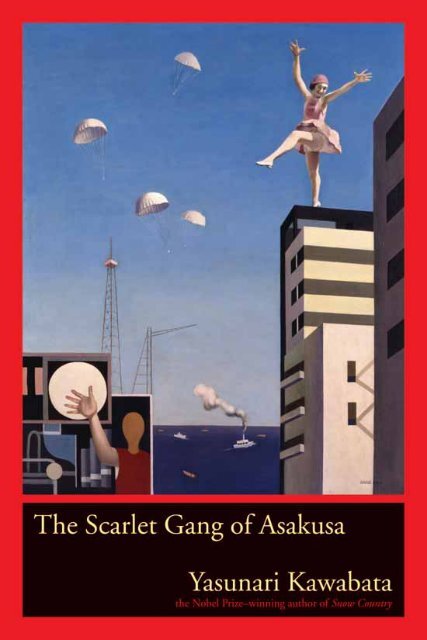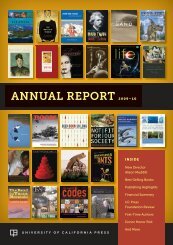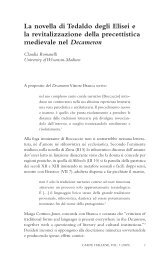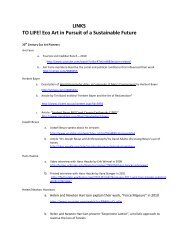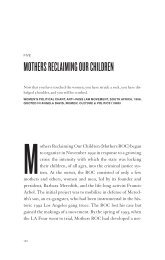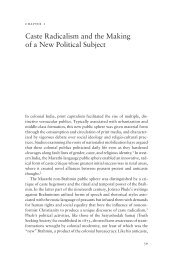Read an Excerpt (PDF) - University of California Press
Read an Excerpt (PDF) - University of California Press
Read an Excerpt (PDF) - University of California Press
Create successful ePaper yourself
Turn your PDF publications into a flip-book with our unique Google optimized e-Paper software.
foreword<br />
donald richie<br />
DURING THE FINAL decades <strong>of</strong> the nineteenth century <strong>an</strong>d the first half<br />
<strong>of</strong> the twentieth, Asakusa was the major entertainment center <strong>of</strong><br />
Tokyo. From the 1840s to the 1940s, it was to Jap<strong>an</strong>’s capital as Montmartre<br />
was to Paris, as the Alex<strong>an</strong>derplatz was to Berlin.<br />
A place <strong>of</strong> merc<strong>an</strong>tile pleasure, it at the same time retained a<br />
neighborhood vitality. It was perhaps this combination <strong>of</strong> brazen<br />
pleasure-mongering <strong>an</strong>d downtown-district virtues that attracted the<br />
crowds. T<strong>an</strong>izaki Jun’ichiro wrote <strong>of</strong> the “innumerable classes <strong>of</strong> visitor<br />
<strong>an</strong>d types <strong>of</strong> entertainment <strong>an</strong>d its const<strong>an</strong>t <strong>an</strong>d peerless richness<br />
preserved even as it furiously ch<strong>an</strong>ges ...swelling <strong>an</strong>d clashing<br />
in confusion <strong>an</strong>d then fusing into harmony.” 1<br />
It was certainly this blending that was mourned when, after the<br />
1923 earthquake, Akutagawa Ryvnosuke wrote <strong>of</strong> “the little pleasure<br />
stalls, all <strong>of</strong> them reduced to cinders ...tiled ro<strong>of</strong>s after a rain,<br />
unlighted votive l<strong>an</strong>terns, pots <strong>of</strong> morning glories, now withered.<br />
This too, all <strong>of</strong> it, was left a charred waste.” 2<br />
Yet Asakusa recovered <strong>an</strong>d, to the end, m<strong>an</strong>aged to retain something<br />
<strong>of</strong> its earlier charm. The novelist Takami Jun wrote in 1939<br />
ix
that Asakusa still had a “peculiar kind <strong>of</strong> warmth.” Though it was<br />
like “a jazz record blaring forth in <strong>an</strong> alien tongue,” it was also “all<br />
shyness <strong>an</strong>d awkwardness as <strong>of</strong> a girl with <strong>an</strong> old-fashioned coiªeur<br />
<strong>an</strong>d <strong>an</strong> adv<strong>an</strong>ced bathing suit.” 3<br />
In a city that saw its pleasures <strong>an</strong>d freedoms curtailed as Jap<strong>an</strong><br />
left behind the liberties <strong>of</strong> the 1920s <strong>an</strong>d 1930s <strong>an</strong>d marched into<br />
the wartime austerities <strong>of</strong> the 1940s, Asakusa remained to<br />
indicate that there was more to life th<strong>an</strong> serving the country. It<br />
might be merc<strong>an</strong>tile, but it was also acceptingly hum<strong>an</strong>. As<br />
observed in a popular song <strong>of</strong> the day by Soeda Azenbo, “Asakusa<br />
is Tokyo’s heart / Asakusa is a hum<strong>an</strong> market.”<br />
ORIGINALLY ASAKUSA was not a part <strong>of</strong> Edo, the original name <strong>of</strong> the<br />
city <strong>of</strong> Tokyo. The district was beyond one <strong>of</strong> the city’s checkpoints<br />
<strong>an</strong>d was initially merely a community serving the needs <strong>of</strong> Senso-ji,<br />
the big K<strong>an</strong>non Temple, which drew hordes <strong>of</strong> both the pious <strong>an</strong>d<br />
pr<strong>of</strong>iteers. During most <strong>of</strong> the Tokugawa period (1600–1868),<br />
Asakusa was just a place to go through. After the sumptuary edicts<br />
<strong>of</strong> the 1840s, which b<strong>an</strong>ned theaters <strong>an</strong>d bordellos in Edo itself, however,<br />
Asakusa <strong>an</strong>d the government-licensed prostitution quarter<br />
<strong>of</strong> Yoshiwara, to its north, were designated places <strong>of</strong> pleasure—<br />
tolerated retreats from the rigors <strong>of</strong> the samurai sternness <strong>of</strong> other<br />
parts <strong>of</strong> the city.<br />
It was only during the Meiji period (1868–1912) that Asakusa<br />
developed its own identity. The novelist Saito Ryokv compared it to<br />
Ueno, a neighboring downtown district, <strong>an</strong>d found that “Ueno is<br />
for the eyes, a park with a view, but Asakusa is for the mouth, a park<br />
for eating <strong>an</strong>d drinking. ...When you go to Ueno you feel the day’s<br />
work isn’t yet finished. When you go to Asakusa you feel that you<br />
have shaken oª tomorrow’s work.” 4<br />
The great Asakusa K<strong>an</strong>non Temple still brought the crowds to<br />
x<br />
foreword
the district, but it was the great pleasure city, Asakusa itself, that<br />
entertained them. Even the foreigners knew about it <strong>an</strong>d went there.<br />
The widely read 1891 guidebook by Basil Hall Chamberlain <strong>an</strong>d<br />
W. B. Mason finds that “the grounds <strong>of</strong> Asakusa are the quaintest<br />
<strong>an</strong>d liveliest place in Tokyo . . . performing monkeys, cheap photographers,<br />
street artists, jugglers, wrestlers, life-sized figures in<br />
clay, venders <strong>of</strong> toys <strong>an</strong>d lollipops <strong>of</strong> every sort, <strong>an</strong>d, circulating<br />
amidst all these cheap attractions, a seething crowd <strong>of</strong> busy holidaymakers.”<br />
5<br />
There were other kinds <strong>of</strong> liveliness as well. An early foreign<br />
observer, W. E. Gri‹s, noted that near the temple were r<strong>an</strong>ged the<br />
archery galleries, “presided over by pretty black-eyed Di<strong>an</strong>as, in paint,<br />
powder <strong>an</strong>d shining coiªure. They bring you tea, smile, talk nonsense,<br />
<strong>an</strong>d giggle ...<strong>an</strong>d then ask you leading <strong>an</strong>d very personal<br />
questions without blushing.... Full-grown able-bodied men...c<strong>an</strong><br />
find amusement for hours at such play.” 6 And later, in the back <strong>of</strong><br />
the stalls, able-bodied men could take further adv<strong>an</strong>tage <strong>of</strong> these<br />
black-eyed Di<strong>an</strong>as.<br />
With its attractions <strong>of</strong> sensationalism <strong>an</strong>d sexuality, Asakusa<br />
prospered. One <strong>of</strong> T<strong>an</strong>izaki’s characters indicated the prote<strong>an</strong> joys<br />
<strong>of</strong> Asakusa in 1911:<br />
Ch<strong>an</strong>ging my costume every night so as not to be noticed, I plunged<br />
into the crowd in Asakusa Park. ...One night I’d tie a scarf over my<br />
head, don a short cotton coat with vertical stripes, apply red polish<br />
to the nails <strong>of</strong> my carefully scrubbed bare feet, <strong>an</strong>d slip on leathersoled<br />
s<strong>an</strong>dals. Another night I might go out wearing gold-rimmed<br />
dark glasses <strong>an</strong>d <strong>an</strong> Inverness with the collar turned up. I enjoyed<br />
using a false beard, a mole, or a birthmark to alter my features. But<br />
one night, at a second-h<strong>an</strong>d clothing shop ...I saw a wom<strong>an</strong>’s lined<br />
kimono with a delicate check pattern against a blue ground, <strong>an</strong>d was<br />
seized with a desire to try it on. 7 foreword xi
Visitors to the Senso Temple in the 1920s.<br />
The Nakamise <strong>an</strong>d the Nio Gate, 1924.
Later, in <strong>an</strong> unfinished novel, The Mermaid (Kojin), T<strong>an</strong>izaki tells<br />
what Asakusa was like in 1918. Its attractions were “plays <strong>of</strong> the old<br />
style, operettas, plays in the new style, comedies, movies—movies<br />
from the West <strong>an</strong>d Jap<strong>an</strong>ese productions, Douglas Fairb<strong>an</strong>ks <strong>an</strong>d<br />
Onoe Matsunosuke—acrobats bal<strong>an</strong>cing on balls, bareback riders,<br />
N<strong>an</strong>iwa bushi singers, girl gidayv ch<strong>an</strong>ters, the merry-go-round, the<br />
H<strong>an</strong>ayashiki Amusement Park, the Twelve Story Tower, shooting<br />
galleries, whores, Jap<strong>an</strong>ese restaur<strong>an</strong>ts, Chinese restaur<strong>an</strong>ts, <strong>an</strong>d<br />
Western restaur<strong>an</strong>ts—the Rairaiken, won ton mein, oysters over<br />
rice, horsemeat, snapping turtles, eels, <strong>an</strong>d the Café Paulista.” 8<br />
There was also the Asakusa Opera, where originally some opera<br />
was actually sung. An early attraction was Rigoletto, <strong>an</strong>d “La donna<br />
é mobile” became a local hit, although, no tenor being available,<br />
the Duke was sung by a sopr<strong>an</strong>o. Shortly, however, the attractions<br />
became more varied. T<strong>an</strong>izaki’s hero here discovered “caricatures<br />
<strong>of</strong> Charlie Chaplin, [<strong>an</strong>d] living reproductions <strong>of</strong> such stars as Pearl<br />
White, Ruth Rol<strong>an</strong>d, Doris Kenyon, Billie Burke, <strong>an</strong>d Dustin Farnum.<br />
The reproductions were, <strong>of</strong> course, crude knock-oªs ...but<br />
paradoxically they charmed the audience precisely because they were<br />
crude.” 9<br />
The Asakusa Opera also me<strong>an</strong>t flesh on view, the firm thighs <strong>of</strong><br />
the chorus line. In a 1942 story, “The Decoration” (“Kunsho”), novelist<br />
Nagai Kafv remembers what it was like. Backstage<br />
was given over to clutter, such a clutter that you wondered how <strong>an</strong>ything<br />
more could possibly be added. An indescribable disorder ...<br />
what first caught the eye, however, was not the violent jumble <strong>of</strong><br />
colors, or even the faces <strong>of</strong> the girls as they sprawled about on the<br />
floor <strong>an</strong>d then sat up again. It was the powerful flesh <strong>of</strong> the arms<br />
<strong>an</strong>d legs ...it called to mind the earthen hallway <strong>of</strong> a florist’s shop,<br />
where a litter <strong>of</strong> torn-oª petals <strong>an</strong>d withering leaves is left unswept<br />
<strong>an</strong>d trampled into shapelessness. 10 foreword xiii
Crudity became <strong>an</strong> Asakusa commodity. The hero <strong>of</strong> T<strong>an</strong>izaki’s<br />
unfinished novel is simult<strong>an</strong>eously repelled <strong>an</strong>d attracted by it. He<br />
confides that he is drawn to Asakusa because, finding Tokyo ugly,<br />
he w<strong>an</strong>ts to “experience this ugliness in its purest state.” He suggests<br />
that “since seeking beauty in this city <strong>of</strong> Tokyo is useless, c<strong>an</strong><br />
it not be said that the most agreeable place to live is Asakusa, where<br />
ugliness bares its essential form?” 11<br />
This crude <strong>an</strong>d ugly but vibr<strong>an</strong>t <strong>an</strong>d sexy Asakusa was soon after<br />
destroyed. The 1923 K<strong>an</strong>to earthquake demolished it, as it demolished<br />
much <strong>of</strong> Tokyo <strong>an</strong>d Yokohama. Among the more famed<br />
calamities was the collapse <strong>of</strong> the Asakusa Twelve Story Tower (the<br />
Ryounkaku, or Cloud-Surpassing Pavilion), a brick structure that had<br />
become synonymous with Asakusa. Also gone was the old neighborhood<br />
structure <strong>of</strong> the place. The sense <strong>of</strong> community, ra‹sh but<br />
real, that had appealed to m<strong>an</strong>y (Akutagawa Ryvnosuke among<br />
them) was never entirely recovered.<br />
Because it was a pleasure city, <strong>an</strong> entertainment capital, one <strong>of</strong><br />
the great night towns <strong>of</strong> the world, however, reconstruction beg<strong>an</strong><br />
at once. And now, symbolizing the new Asakusa, instead <strong>of</strong> the<br />
Twelve Story Tower there was the Subway Tower building, with its<br />
observation platform. Kawabata said it was in the Osaka style, all the<br />
floors except the top being eating places. This influence <strong>of</strong> Osaka,<br />
known for commerce rather th<strong>an</strong> culture, upon what was left <strong>of</strong> old<br />
Edo was commonly lamented. “Why, it’s gotten just like Osaka,”<br />
complains a character in one Kawabata story.<br />
Actually, it was like no place else on earth. In commenting on<br />
The Scarlet G<strong>an</strong>g <strong>of</strong> Asakusa, Kataoka Yoshikaze, writing in 1939, described<br />
the new Asakusa as that “hum<strong>an</strong> market” where<br />
the pleasure resort <strong>of</strong> the Edo period, the vestiges <strong>of</strong> the crude, semienlightened<br />
curiosity <strong>of</strong> the Meiji era, <strong>an</strong>d the over-ripeness ...<strong>of</strong><br />
the present era <strong>of</strong> capitalist corruption, are thrown together in a<br />
xiv<br />
foreword
The Rokku, the cinema <strong>an</strong>d theater district <strong>of</strong> Asakusa Park, in the late 1920s.<br />
The Rokku <strong>an</strong>d its cinemas <strong>an</strong>d revue halls, 1933.
Movie theaters in Asakusa Park around 1930.<br />
Movie theaters in the Rokku in the second half <strong>of</strong> the 1920s.
forever disordered state. Or org<strong>an</strong>ized in a m<strong>an</strong>ner peculiarly like the<br />
place itself. Eroticism <strong>an</strong>d frivolity <strong>an</strong>d speed <strong>an</strong>d comic-strip humor;<br />
the bare legs <strong>of</strong> d<strong>an</strong>cing girls <strong>an</strong>d jazzy revues; kiss-d<strong>an</strong>ces, foreign<br />
girls, ground-cherries <strong>an</strong>d popular songs; the movie, the circus, the<br />
fake, dilapidated aquarium <strong>an</strong>d insectarium. Here the girls bob their<br />
hair <strong>an</strong>d “Bobbed-hair” so-<strong>an</strong>d-so, wearing a red dress, plays the pi<strong>an</strong>o,<br />
deep in a narrow backstreet l<strong>an</strong>e, with her knees exposed. Her<br />
rendezvous notes are scribbled on the back <strong>of</strong> the Goddess K<strong>an</strong>non’s<br />
written oracles. 12<br />
Like Montmartre in the 1890s, like New York’s Times Square<br />
in the 1940s, the place was license itself. In The Scarlet G<strong>an</strong>g <strong>of</strong> Asakusa,<br />
Kawabata quotes Soeda Azenbo’s heightened description: “In<br />
Asakusa, everything is flung out in the raw. Desires d<strong>an</strong>ce naked.<br />
All races, all classes, all jumbled together forming a bottomless, endless<br />
current, flowing day <strong>an</strong>d night, no beginning, no end. Asakusa<br />
is alive.”<br />
AMONG ALL THESE varied attractions, one <strong>of</strong> the most popular was the<br />
cinema, a form <strong>of</strong> entertainment early associated with Asakusa because<br />
the first Tokyo movie house, the Denkik<strong>an</strong>, had opened there<br />
in 1903. Here one could see the wonders <strong>of</strong> the West; after 1932,<br />
one could even hear them—Marlene Dietrich <strong>an</strong>d Gary Cooper talking<br />
to each other in Morocco, one <strong>of</strong> the first films subtitled for Jap<strong>an</strong>ese<br />
audiences.<br />
Kawabata noted that by 1930, Asakusa had fourteen movie<br />
houses. He also stated, however, that it had even more live theaters.<br />
(In addition, his survey counted half a dozen vaudeville, or yose,<br />
halls, one kabuki theater, the largest number <strong>of</strong> pawnshops in the<br />
city, <strong>an</strong>d the most beggars: in the summer <strong>of</strong> 1930, some eight hundred<br />
were living in Asakusa Park, though Kawabata did not trust<br />
this o‹cial estimate <strong>an</strong>d maintained that there were far more.)<br />
foreword<br />
xvii
Kawabata himself eschewed the screen in favor <strong>of</strong> the stage, in<br />
particular the Asakusa revue, a d<strong>an</strong>ce <strong>an</strong>d comedy show with erotic<br />
undertones first performed in 1929 by the Casino Folies (Kashino<br />
Fori). He described this perform<strong>an</strong>ce as composed <strong>of</strong> “eroticism <strong>an</strong>d<br />
nonsense <strong>an</strong>d speed, <strong>an</strong>d humor in the vein <strong>of</strong> the topical cartoon,<br />
the jazz song, legs.” 13 Ero guro was the spirit <strong>of</strong> the age. This combination<br />
<strong>of</strong> the first syllables <strong>of</strong> “erotic” <strong>an</strong>d “grotesque” typified<br />
that combination <strong>of</strong> the sexy <strong>an</strong>d the absurd <strong>an</strong>d characterized the<br />
m<strong>an</strong>y entertainments <strong>of</strong> Asakusa: on the one h<strong>an</strong>d, the firmthighed<br />
chorines, <strong>an</strong>d on the other (since Meiji times, it was said),<br />
the m<strong>an</strong> who smoked through his navel.<br />
Kawabata’s novel made the Casino Folies famous, though the revue’s<br />
leading comedi<strong>an</strong>, Enoken, said that its popularity was based<br />
only on the false rumor that on Fridays the chorus girls dropped<br />
their p<strong>an</strong>ties. In <strong>an</strong>y case, the novelist also gave us our only real<br />
record <strong>of</strong> what the place was like.<br />
Kawabata shows us Asakusa at its prewar prime. The Scarlet G<strong>an</strong>g<br />
<strong>of</strong> Asakusa captures the area at its most Asakusa-like, a hundred million<br />
people a year, a hum<strong>an</strong> wave, money spilled into shows, eateries,<br />
geisha houses, a world frivolous, frenetic, <strong>an</strong>d filled with flesh.<br />
“Asakusa is like a specimen in the Bug House,” says the narrator<br />
<strong>of</strong> the novel, “something completely diªerent from today’s world,<br />
like a remote isl<strong>an</strong>d or some Afric<strong>an</strong> village.”<br />
Soon after that, the place beg<strong>an</strong> its decline. Exotic bloom that it<br />
was, in increasingly illiberal Jap<strong>an</strong>, Asakusa beg<strong>an</strong> to fade. Takami<br />
Jun wrote that by 1938, “The famous old places <strong>of</strong> Asakusa had<br />
been ab<strong>an</strong>doned. ...The birthplace <strong>of</strong> the Asakusa revues was in<br />
a state <strong>of</strong> adv<strong>an</strong>ced neglect, the subject <strong>of</strong> weird stories. Late at night,<br />
it was said, you could hear the sound <strong>of</strong> tap d<strong>an</strong>cing on the ro<strong>of</strong>. It<br />
has since been torn down, <strong>an</strong>d so those who loved the Casino Folies<br />
have lost all trace <strong>of</strong> their dream.” 14<br />
xviii<br />
foreword
The military takeovers <strong>of</strong> the 1940s subdued even more the<br />
Asakusa spirit. Nagai Kafv, one cold night in 1944, recorded the<br />
closing <strong>of</strong> the Opera House, his favorite. “As I passed the l<strong>an</strong>e <strong>of</strong><br />
shops...on my way to the subway, I found myself weeping again. . . .<br />
I have been witness to it all, Tokyo going to ruin.” 15<br />
It went completely to ruin in 1945. In the U.S. incendiary raids<br />
<strong>of</strong> March 9 <strong>an</strong>d 10, between 70,000 <strong>an</strong>d 80,000 people were killed,<br />
<strong>an</strong>d some two-fifths <strong>of</strong> the city was destroyed—Asakusa, too. The<br />
K<strong>an</strong>non Temple was hit at one-thirty in the morning <strong>an</strong>d was consumed<br />
by flames in just two hours.<br />
After the conclusion <strong>of</strong> the Pacific war, the Allied Occupation authorities<br />
gave much <strong>of</strong> the l<strong>an</strong>d in Asakusa to the K<strong>an</strong>non Temple,<br />
which, having no money <strong>of</strong> its own, sold it. Thus, Asakusa Park, with<br />
its famous pond, disappeared. The area behind the temple was turned<br />
into a parking lot for tourist buses; <strong>an</strong>other portion went to a motion-picture<br />
comp<strong>an</strong>y, which built a theater <strong>an</strong>d <strong>an</strong> amusement hall.<br />
That postwar innovation, the strip show, was visible from 1948—<br />
more flesh th<strong>an</strong> ever before seen, with variations as well: the bath<br />
strip, the tightrope strip, etc. But all this activity was illusory. Tokyo<br />
was moving west; Shinjuku was the new night town, <strong>an</strong>d Asakusa<br />
was forgotten. By 1966 one newspaper headlined, “Deserted Place,<br />
Thy Name Is Asakusa.” 16<br />
ASAKUSA EARLY HELD a fascination for Kawabata. He once said that for<br />
three years during his high school days, he commuted daily, rain<br />
or shine, between two popular Asakusa gathering places, the Café<br />
Paris <strong>an</strong>d the Café Elb<strong>an</strong>.One day he glimpsed T<strong>an</strong>izaki, some thirteen<br />
years his senior <strong>an</strong>d already a well-known writer, at the nearby<br />
Nihonk<strong>an</strong>, surrounded by pretty girls, <strong>an</strong>d thought that this would<br />
someday be he.<br />
After graduating from high school in 1920, the twenty-one-yearforeword<br />
xix
The Twelve Story Tower. Built in 1890, the tower was Tokyo’s tallest building.<br />
It was destroyed in the 1923 Great K<strong>an</strong>to Earthquake. This photo<br />
was taken sometime between 1910 <strong>an</strong>d 1923.<br />
old Kawabata, though nominally a Tokyo Imperial <strong>University</strong> student,<br />
rented his own place in Asakusa, on the second floor <strong>of</strong> a hat<br />
repair shop, <strong>an</strong>d started to write.<br />
He was in his room when the 1923 earthquake hit, but the building<br />
stood <strong>an</strong>d he escaped unhurt. His first reaction, as soon as the<br />
tremors stopped, was to round up fellow writers Kon Toko <strong>an</strong>d Akutagawa<br />
Ryvnosuke <strong>an</strong>d make a walking tour <strong>of</strong> the ruins. He continued<br />
taking long walks every day, carrying with him a jug <strong>of</strong> water<br />
<strong>an</strong>d something to eat in his knapsack. Later he wrote that there<br />
couldn’t have been m<strong>an</strong>y who saw so plainly what the earthquake<br />
had done.<br />
He was also neglecting his Imperial <strong>University</strong> studies. A contemporary<br />
noted that the student Kawabata was “more fond <strong>of</strong><br />
soaking in the public bath th<strong>an</strong> <strong>of</strong> attending classes.” 17 He was writing,<br />
however, <strong>an</strong>d later he became the editor <strong>of</strong> a new magazine,<br />
xx<br />
foreword
The Age <strong>of</strong> Literary Arts (Bungei Jidai). In it, he said his ambition<br />
was to view every incident <strong>of</strong> the hum<strong>an</strong> condition through new eyes.<br />
The critics dutifully labeled his group the New Perception School<br />
(Shink<strong>an</strong>kaku-ha).<br />
Viewing every incident through new eyes was one <strong>of</strong> the tenets<br />
<strong>of</strong> the new aesthetic movement, modernism. This is a loose label,<br />
indeed, but it may be at least provisionally defined. According to<br />
Malcolm Bradbury, it is experimental, formally complex, <strong>an</strong>d elliptical.<br />
The l<strong>an</strong>guage is <strong>of</strong>ten awry, cultural cohesion is lost, perception<br />
is pluralized. It “tends to associate notions <strong>of</strong> the artist’s freedom<br />
from realism, materialism, traditional genre <strong>an</strong>d form, with<br />
notions <strong>of</strong> cultural apocalypse <strong>an</strong>d disaster.” 18<br />
A body <strong>of</strong> writers illustrates the concept. Among them are<br />
Proust, M<strong>an</strong>n, Gide, Kafka, <strong>an</strong>d Joyce in fiction; Strindberg, Pir<strong>an</strong>dello,<br />
Wedekind, <strong>an</strong>d Brecht in drama; Mallarmé, Eliot, <strong>an</strong>d Rilke<br />
in poetry. Their works are <strong>of</strong>ten aesthetically radical <strong>an</strong>d technically<br />
innovative, <strong>of</strong>ten emphasize spatial as opposed to chronological<br />
forms, tend toward irony, <strong>an</strong>d involve what Ortega y Gasset (who<br />
did not like modernism) called a certain “dehum<strong>an</strong>ization <strong>of</strong> art.” 19<br />
Kawabata knew modernist narrative—indeed, he had already created<br />
some. In 1926 he wrote the scenario for A Page Out <strong>of</strong> Order<br />
(Kurutta ichipeji), Kinugasa Teisuke’s modernist film (produced<br />
by the New Perceptionist School Motion Picture Federation). Like<br />
everyone else, Kawabata had seen Robert Wiene’s Das Kabinett des<br />
Dr. Caligari, a modernist l<strong>an</strong>dmark <strong>an</strong>d <strong>an</strong>other film set in <strong>an</strong> ins<strong>an</strong>e<br />
asylum.<br />
In addition, though he understood English only with di‹culty,<br />
he had attempted to read Ulysses. One wonders if he also knew about<br />
the other big-city modernist novels <strong>of</strong> the period, Bely’s 1916 Petersburg<br />
<strong>an</strong>d Döblin’s 1929 Berlin Alex<strong>an</strong>derplatz. He certainly knew<br />
Sh<strong>an</strong>ghai (1928–1931), then being written by his best friend <strong>an</strong>d felforeword<br />
xxi
Poster for the Casino Folies revue, June 9, 1930.<br />
low New Perceptionist, Yokomitsu Riichi. Indeed, Kawabata stated<br />
that Sh<strong>an</strong>ghai was the “gr<strong>an</strong>d summation <strong>of</strong> the methods” <strong>of</strong> the<br />
New Perceptionist School. 20 And he had early had some knowledge<br />
<strong>of</strong> the aims <strong>of</strong> modernism. Marinetti’s 1909 Declaration <strong>of</strong> the Futurists<br />
had been tr<strong>an</strong>slated by prominent literary figure (<strong>an</strong>d Jap<strong>an</strong>’s<br />
surgeon general) Mori Ogai <strong>an</strong>d published in Jap<strong>an</strong> the same year<br />
it came out in Italy.<br />
xxii<br />
foreword
He would also have been familiar with Nagai Kafv’s Geisha in<br />
Rivalry (Udekurabe), published in 1916. In it, one <strong>of</strong> the characters,<br />
having visited <strong>an</strong> Asakusa prostitute, walks back past the K<strong>an</strong>non<br />
Temple <strong>an</strong>d stops to look at it, then recalls that “he had once read,<br />
in some magazine or other, a review <strong>of</strong> a novel by Blasco Ibáñez<br />
called La Catedral ...[which] had used the cathedral <strong>of</strong> Toledo as a<br />
focus for sketching the lives <strong>of</strong> those who lived in its environs. It<br />
had immediately occurred to [him] to write a novel applying this idea<br />
to the K<strong>an</strong>non Temple <strong>of</strong> Asakusa.” 21 Nothing came <strong>of</strong> this, but four<br />
years later T<strong>an</strong>izaki set out to write just this sort <strong>of</strong> book, The Mermaid.<br />
Nothing came <strong>of</strong> this either—the author ab<strong>an</strong>doned it after<br />
two hundred pages. It was Kawabata who finally wrote the novel you<br />
are about to begin.<br />
The author would also have known that Asakusa had already been<br />
singled out as the best place to study the popular culture that formed<br />
the basis <strong>of</strong> the kind <strong>of</strong> modernism that interested him. In 1921,<br />
Gonda Yasunosuke, scholar <strong>of</strong> Jap<strong>an</strong>ese popular culture, told his students,<br />
“Go to Asakusa—Asakusa’s your text.” 22 His advice became<br />
famous, <strong>an</strong>d a number <strong>of</strong> students did their fieldwork there.<br />
Kawabata moved to Asakusa in 1929. He already knew it well<br />
from his high school days <strong>an</strong>d its post-earthquake days. Now he beg<strong>an</strong><br />
to frequent the Casino Folies, which had just opened, taking<br />
notes about the d<strong>an</strong>cers <strong>an</strong>d the lives <strong>of</strong> the demimonde. It was these<br />
notes that were made into the novel The Scarlet G<strong>an</strong>g <strong>of</strong> Asakusa, its<br />
sequel, <strong>an</strong>d his other Asakusa writings.<br />
In this way, Kawabata later said, he made use <strong>of</strong> his three years<br />
<strong>of</strong> research walking around Asakusa. “All I did was walk. I never<br />
became acquainted with <strong>an</strong>y <strong>of</strong> the young delinquents. I never addressed<br />
a word to the vagr<strong>an</strong>ts either ...but I took my notes.” 23 He<br />
was not interested in journalism, or in reportage. He w<strong>an</strong>ted to write<br />
down what he saw <strong>an</strong>d to display it in modernist form.<br />
foreword<br />
xxiii
In 1930, when Kawabata was still living in Asakusa, Gonda Yasunosuke<br />
completed a study <strong>of</strong> the area, in which he wrote that in<br />
Asakusa, the diªerences were all visible—that he could show, as<br />
though in relief, what restaur<strong>an</strong>ts sold what <strong>an</strong>d who ate or dr<strong>an</strong>k<br />
it, which diªerent classes went to the movies, the vaudeville halls,<br />
the stage shows. He included the sizes <strong>of</strong> the businesses, distinguished<br />
the employees by sex <strong>an</strong>d age, <strong>an</strong>d counted the diªerent<br />
sorts <strong>of</strong> enterprise native only to that place. 24<br />
This is, in a way, what Kawabata was attempting as well, except<br />
that he was creating not a work <strong>of</strong> adv<strong>an</strong>ced sociology, but a modernist<br />
novel. Gonda contended that the excesses <strong>of</strong> Asakusa were<br />
not intended as escapes from the economic recession then gripping<br />
Jap<strong>an</strong>, but as resist<strong>an</strong>ce to the social conventions reinforced by monopoly<br />
capital. Kawabata had much the same aim, to show the vitality<br />
<strong>of</strong> the place <strong>an</strong>d the people, but his me<strong>an</strong>s were artistic.<br />
In this he was somewhat like Virginia Woolf, <strong>an</strong>other writer he<br />
had tried to read. His Tokyo is like Mrs. Dalloway’s London. It is<br />
composed <strong>of</strong> a collection <strong>of</strong> seemingly r<strong>an</strong>dom perceptions unattached<br />
to social issues. A diªerence is that Kawabata’s novel is also<br />
(<strong>an</strong>other modernist strategy) a commentary on itself. To begin with,<br />
it is a pop novel, complete with two-dimensional m<strong>an</strong>ga or comicbook<br />
characters <strong>an</strong>d a gag title—Asakusa kurenaid<strong>an</strong> sounds just<br />
as jokey in Jap<strong>an</strong>ese as The Scarlet G<strong>an</strong>g <strong>of</strong> Asakusa does in English.<br />
It employs a comic deflation <strong>of</strong> the past, as when Prince Genji <strong>an</strong>d<br />
Lord Narihira caper together on the same stage. There is purposely<br />
hokey melodrama, as in the boat scenes, which feature Yumiko’s<br />
p<strong>an</strong>ther leaps <strong>an</strong>d her notorious arsenic kiss. There are pop tag lines,<br />
such as “Follow those bikes!”<br />
At the same time, there is serious dislocation. The story is <strong>of</strong>ten<br />
broken into <strong>an</strong>d is at one point ab<strong>an</strong>doned <strong>an</strong>d not rediscovered until<br />
the final page. There are “cubist” catalogues, such as the various<br />
xxiv<br />
foreword
views from the Subway Tower, so timed as to disturb <strong>an</strong>y idea <strong>of</strong><br />
continuity. And there is much questioning <strong>of</strong> the narrative itself,<br />
as in the pretense that events influenced its composition: “By the<br />
way, dear reader, as for Yumiko ...When I’d reached this point in<br />
my story, I met Yumiko in a str<strong>an</strong>ge way, <strong>an</strong>d so my novel must also<br />
suddenly ch<strong>an</strong>ge course.”<br />
Insisting upon artificiality, Kawabata maintains throughout that,<br />
as he says at the beginning, “in the end, this is just a novel.” And<br />
at the end, he indicates it. Suddenly, Yumiko reappears, this time<br />
dressed up as a young peddler from the isl<strong>an</strong>d <strong>of</strong> Oshima <strong>an</strong>d is<br />
selling its local product, camellia oil for the hair. Kawabata knows<br />
that his readers will be aware that “selling oil” (abura o uru) is a<br />
colloquialism for pulling a fast one <strong>an</strong>d getting away with it. This<br />
then, he now indicates, is just what he has done with his novel—<br />
getting away with it becomes a metaphor for his book <strong>an</strong>d his<br />
method.<br />
Recondite as all this is, the book was intended for a popular audience<br />
<strong>an</strong>d was originally serialized in the widely read Asahi newspaper.<br />
It was as though Ulysses, hot from Joyce’s pen, had appeared<br />
weekly in the London Times. This was possible because in Jap<strong>an</strong>, then<br />
as now, the av<strong>an</strong>t-garde is at once incorporated into the taste <strong>of</strong> the<br />
masses, so strong is the lure <strong>of</strong> the new. Also, in Kawabata’s novel,<br />
the br<strong>an</strong>d new came s<strong>an</strong>dwiched between the tried <strong>an</strong>d true.<br />
In it, the reader savors<br />
the curious inebriation induced by a cocktail made, as it were, from<br />
[Asakusa’s] tradition <strong>an</strong>d its modernism. Hence, as a story, it is not<br />
aimed at a consistently integrated delineation <strong>of</strong> characters <strong>an</strong>d incidents,<br />
the latter having been treated merely as bubbles <strong>of</strong> all sorts<br />
<strong>an</strong>d shapes that give form to the swirling currents <strong>of</strong> Asakusa, leaving<br />
them to rise <strong>an</strong>d v<strong>an</strong>ish at will, <strong>an</strong>d thus creating numerous focal<br />
points in the narrative <strong>an</strong>d rendering its sensation both intricate<br />
foreword<br />
xxv
<strong>an</strong>d m<strong>an</strong>y-sided. . . . Cutting, linking, superimposing, unraveling, the<br />
story is plotted out on a bewildering scale which is at once variable<br />
<strong>an</strong>d involved <strong>an</strong>d which, in short, is very like the cinema. 25<br />
Certainly, the narrative is very unlike that <strong>of</strong> the ordinary novel.<br />
Seiji M. Lippit, in his masterly exegesis <strong>of</strong> The Scarlet G<strong>an</strong>g <strong>of</strong><br />
Asakusa, has identified m<strong>an</strong>y <strong>of</strong> the diªerences. There is a multiplicity<br />
<strong>of</strong> writing styles <strong>an</strong>d genres, along with aggregated l<strong>an</strong>guage<br />
<strong>an</strong>d much sl<strong>an</strong>g. The literary mixes with the non-literary, resulting<br />
in a fragmentary style, that <strong>of</strong> reportage <strong>an</strong>d descriptive poetry. The<br />
narrative moves from image to image, a progression Kawabata said<br />
was like “the succession <strong>of</strong> images in a newsreel” <strong>an</strong>d that insisted<br />
upon a “free <strong>an</strong>d reckless association.” 26<br />
The conventional novelistic structure is, in the process, dism<strong>an</strong>tled,<br />
<strong>an</strong>d there is a willful confusion <strong>of</strong> tenses <strong>an</strong>d persons.<br />
Amid all this Lippit has identified three narrative voices: first, the<br />
narrator, the one addressing the “dear reader”; second, this narrator<br />
as character in the novel itself; <strong>an</strong>d third, <strong>an</strong>other voice, objective,<br />
in the third person, recounting things the first two voices could<br />
not know. 27<br />
All <strong>of</strong> this accounts for the famous di‹culty <strong>of</strong> the text. Critic<br />
Maeda Ai has said that when he first tried to read it, as a college<br />
student, he couldn’t make it to the end. The famous opening—one<br />
long, m<strong>an</strong>y-claused sentence, beginning with confusing particulars<br />
<strong>an</strong>d only widening into its subject at the end—all but defies<br />
tr<strong>an</strong>slation.<br />
The structure is equally unexpected. The book stops in the middle<br />
while new protagonists take over, <strong>an</strong>d it is not until the final pages<br />
that the story we beg<strong>an</strong> with suddenly returns. In the me<strong>an</strong>time,<br />
the work turns self-referential, with asides referring to its own popularity,<br />
even to the stage <strong>an</strong>d screen versions <strong>of</strong> it. The Scarlet G<strong>an</strong>g<br />
<strong>of</strong> Asakusa, Edward Seidensticker has said, is like Asakusa itself:<br />
xxvi<br />
foreword
“m<strong>an</strong>nered, diªuse, obscure, <strong>an</strong>d inconclusive even as Kawabata<br />
novels go ...but it is interesting.” 28 Certainly, some <strong>of</strong> this is due<br />
to the author’s becoming a modernist. Kawabata was familiar with<br />
the foreign models, <strong>an</strong>d his idea <strong>of</strong> what the new perception <strong>an</strong>d<br />
new art ought to consist <strong>of</strong> precluded much that might have been<br />
expected.<br />
V<strong>an</strong> C. Gessel has written that “the attempt to adopt some <strong>of</strong> the<br />
techniques <strong>of</strong> Europe<strong>an</strong> modernism <strong>an</strong>d the struggle to break away<br />
from the flat, overly realistic <strong>an</strong>d autobiographical tendencies that<br />
dominated the first two decades <strong>of</strong> the twentieth century in Jap<strong>an</strong><br />
are noteworthy achievements. Much that seems surprising, elliptical<br />
<strong>an</strong>d sometimes even odd in Kawabata’s writing c<strong>an</strong> be traced to his<br />
days as a New Perceptionist.” 29 It c<strong>an</strong> also be attributed to his membership<br />
(<strong>an</strong>d he was one <strong>of</strong> the founding members) in the New Art<br />
School (Shinkogeijutsu-ha), that short-lived org<strong>an</strong>ization formed in<br />
opposition both to old-fashioned naturalist literature <strong>an</strong>d newf<strong>an</strong>gled<br />
proletari<strong>an</strong> tracts. The New Art School shared m<strong>an</strong>y aims with<br />
the New Perceptionists, but there were m<strong>an</strong>y diªerences as well.<br />
The New Art School certainly emphasized <strong>an</strong> a‹liation with that<br />
subgenre that Alisa Freedm<strong>an</strong> has identified as the laconic “urb<strong>an</strong><br />
sketch,” which she characterizes thus: “ The urb<strong>an</strong> gaze is not a meditative<br />
one <strong>an</strong>d instead is a fleeting look at the barrage <strong>of</strong> spectacles<br />
that pass before the eyes <strong>of</strong> the viewer like the l<strong>an</strong>dscape seen from<br />
the window <strong>of</strong> a moving train.” 30<br />
At the same time, one c<strong>an</strong> also say, as Edward Seidensticker has,<br />
that “the influence <strong>of</strong> Edo literature [on The Scarlet G<strong>an</strong>g <strong>of</strong> Asakusa]<br />
is so strong as to make it seem almost imitative. It is not typical<br />
Kawabata. The investigation <strong>of</strong> lonely lives on the edge <strong>of</strong> the Asakusa<br />
demimonde is, however, close to the central preoccupation <strong>of</strong><br />
Kawabata’s writing.” 31<br />
The role <strong>of</strong> observer was one Kawabata felt fit not only the aspiforeword<br />
xxvii
ations <strong>of</strong> the New Perception School but also his own nature. M<strong>an</strong>y<br />
critics have noticed how the role <strong>of</strong> observer seems to define or limit<br />
his fiction. The detachment <strong>an</strong>d dist<strong>an</strong>cing he showed in all <strong>of</strong> his<br />
work was the domin<strong>an</strong>t theme <strong>of</strong> his own life—the loss <strong>of</strong> both<br />
parents when he was four, then, one by one, the demise <strong>of</strong> the rest<br />
<strong>of</strong> the family, <strong>an</strong>d unhappy love aªairs, one with a fellow student,<br />
later one with a girl. Isolated, he chose to maintain this separation<br />
between self <strong>an</strong>d others both in his work <strong>an</strong>d in his life.<br />
The detached, watching narrator communicating elliptical fragments<br />
<strong>of</strong> his vision also has some precedents in Jap<strong>an</strong>ese literature.<br />
The protagonists <strong>of</strong> that genre known as the shishosetsu (watakushi<br />
shosetsu, the first-person-singular novel) share this regard, though<br />
it is more <strong>of</strong>ten self-regard.<br />
Kawabata was, however, at least in his Asakusa writings, a special<br />
kind <strong>of</strong> spectator. He was a flâneur, one who strolled about, committing<br />
himself to nothing <strong>an</strong>d no one. An <strong>of</strong>ten ironic observer,<br />
he turned perception itself into a kind <strong>of</strong> judgment. Like Baudelaire<br />
on the boulevard, Kawabata in Asakusa was a literary d<strong>an</strong>dy whose<br />
gaze was his only comment.<br />
When Kawabata went to study Asakusa, he was, at the same time<br />
turning against the respectable life <strong>of</strong> a university student with <strong>an</strong><br />
assured social position. His first popular success, The Izu D<strong>an</strong>cer<br />
(Izu no Odoriko), is about a student who, rather th<strong>an</strong> studying,<br />
w<strong>an</strong>ders the countryside <strong>of</strong> Izu <strong>an</strong>d encounters <strong>an</strong> itiner<strong>an</strong>t performing<br />
group <strong>an</strong>d the very young d<strong>an</strong>cer who excites his regard.<br />
In one <strong>of</strong> his last books, The House <strong>of</strong> the Sleeping Beauties (Nemureru<br />
Bijo), the narrator is <strong>an</strong> old m<strong>an</strong> who pays to sleep with heavily<br />
drugged young girls who are unaware <strong>of</strong> his loving, critical, intrusive,<br />
accepting gaze.The young girls <strong>of</strong> The Scarlet G<strong>an</strong>g <strong>of</strong> Asakusa—<br />
Yumiko, Haruko, <strong>an</strong>d all the rest—are members <strong>of</strong> this crew that<br />
so attracted the author all his life.<br />
xxviii<br />
foreword
The eleg<strong>an</strong>t stroller is also slumming—the regard <strong>of</strong> the flâneur<br />
is also the open stare <strong>of</strong> the voyeur. Kawabata in this novel says<br />
he is afraid <strong>of</strong> being like the Edo poet Ota N<strong>an</strong>po, also known as<br />
Shokus<strong>an</strong>jin <strong>an</strong>d characterized as “a debauched m<strong>an</strong> <strong>of</strong> letters.” Yet<br />
his apparent fears invite our speculations.<br />
“That’s Asakusa,” he proclaims at each new revelation, apparently<br />
not noticing his own condescension or that he is reveling in<br />
“this world-<strong>of</strong>-nothingness garbage-c<strong>an</strong> <strong>of</strong> Asakusa.” The lower<br />
classes, as they would be called, seem to invite this regard. And the<br />
lower classes at play seem to make it m<strong>an</strong>datory. Asakusa thus<br />
strongly appealed to those with a nostalgie de la boue or, as Kawabata<br />
phrased it, a “taste for back streets.” 32<br />
This savoring <strong>of</strong> the lower classes is <strong>of</strong>ten aligned to a taste for<br />
control. Not only is the “mud” found more “authentic” th<strong>an</strong> <strong>an</strong>ything<br />
upper class, it is also found to be more malleable. Paul<br />
Mor<strong>an</strong>d in Montmartre, Carl V<strong>an</strong> Vechten in Harlem, Paul Bowles<br />
in T<strong>an</strong>gier—all are examples <strong>of</strong> men who found their métier in becoming<br />
purposely, if temporarily, déclassé. They found a new (sometimes<br />
finer, more admirable) authenticity, they found a container<br />
for their own feelings, <strong>an</strong>d, though <strong>of</strong>ten powerless in their own<br />
social spheres, they found something they could control. It was not<br />
a question <strong>of</strong> patronization, however, or <strong>of</strong> venting simple superiority.<br />
This “taste for back streets” contains a sincere admiration coupled<br />
with <strong>an</strong> equally deeply felt need to m<strong>an</strong>ipulate. It is this combination<br />
that lends such a sense <strong>of</strong> conviction in this literature.<br />
The Scarlet G<strong>an</strong>g <strong>of</strong> Asakusa was written swiftly. By December<br />
1929, it was already being serialized in Jap<strong>an</strong>’s most-read newspaper.<br />
The Izu D<strong>an</strong>cer had made the writer famous, <strong>an</strong>d here was a<br />
new work that promised even more. It proved quite popular, created<br />
a kind <strong>of</strong> Asakusa vogue, <strong>an</strong>d made a sensation <strong>of</strong> the Casino<br />
Folies. Having read the novel, people started to come to see the place,<br />
foreword<br />
xxix
<strong>an</strong>d for a time it comm<strong>an</strong>ded the attention <strong>of</strong> what Kawabata disdainfully<br />
called the “Ginza people.” Perhaps it was in scorn <strong>of</strong> such<br />
success (though he was slumming no less th<strong>an</strong> they) that Kawabata<br />
said that in his work he had used only a hundredth <strong>of</strong> his material<br />
<strong>an</strong>d that even so, he was ashamed <strong>of</strong> the results.<br />
Or perhaps it was that modernism as a technique no longer<br />
expressed his needs. A number <strong>of</strong> writers during this period—<br />
Yokomitsu Riichi, Ito Sei, Hori Tatsuo, Sato Haruo—were experimenting<br />
with the style. All <strong>of</strong> them, including Kawabata, ab<strong>an</strong>doned<br />
it. Stephen Snyder speaks <strong>of</strong> “the general consensus that the attempt<br />
to find a Jap<strong>an</strong>ese idiom in which to render the verbal pyrotechnics<br />
<strong>of</strong> the Europe<strong>an</strong> br<strong>an</strong>d <strong>of</strong> modernism was by <strong>an</strong>d large a failure.” 33<br />
If Kawabata was truly ashamed, he shouldn’t have been. The Scarlet<br />
G<strong>an</strong>g <strong>of</strong> Asakusa may have been one-shot modernism, but it eªortlessly<br />
captures a remarkable era <strong>an</strong>d a fascinating place, both now<br />
gone. It also was the theater where Kawabata could create a persona<br />
for his first-person singular, for a narrator who was not himself, one<br />
who had no authorial validity but without whom he could not express<br />
observations, justifications, reflections <strong>of</strong> the place as he really<br />
found it. Both personality <strong>an</strong>d place are joined, face to face, in this<br />
evocation <strong>of</strong> somewhere that never existed <strong>an</strong>d somewhere that did.<br />
NOTES<br />
1. Paul Waley, Tokyo Now <strong>an</strong>d Then: An Explorer’s Guide (New York: Weatherhill,<br />
1984), 176.<br />
2. Edward Seidensticker, Low City, High City: Tokyo from Edo to the Earthquake<br />
(Cambridge, MA: Harvard <strong>University</strong> <strong>Press</strong>, 1983), 208–209.<br />
3. Edward Seidensticker, Tokyo Rising: The City Since the Great Earthquake<br />
(Cambridge, MA: Harvard <strong>University</strong> <strong>Press</strong>, 1990), 113.<br />
4. Seidensticker, Low City, High City, 119.<br />
5. Ibid., 158.<br />
6. Ibid., 207.<br />
xxx<br />
foreword
7. Jun’ichiro T<strong>an</strong>izaki, “The Secret,” tr<strong>an</strong>s. Anthony Hood Chambers, in<br />
Aileen Gatten <strong>an</strong>d Anthony Hood Chambers, eds., New Leaves: Studies<br />
<strong>an</strong>d Tr<strong>an</strong>slations <strong>of</strong> Jap<strong>an</strong>ese Literature in Honor <strong>of</strong> Edward Seidensticker<br />
(Ann Arbor: Center for Jap<strong>an</strong>ese Studies, <strong>University</strong> <strong>of</strong> Michig<strong>an</strong>, 1993),<br />
161–162.<br />
8. Ken K. Ito, Visions <strong>of</strong> Desire: T<strong>an</strong>izaki’s Fictional Worlds (St<strong>an</strong>ford, CA:<br />
St<strong>an</strong>ford <strong>University</strong> <strong>Press</strong>, 1991), 69–70.<br />
9. Ibid., 73.<br />
10. Edward Seidensticker, Kafv the Scribbler: The Life <strong>an</strong>d Writings <strong>of</strong> Nagai<br />
Kafv (St<strong>an</strong>ford, CA: St<strong>an</strong>ford <strong>University</strong> <strong>Press</strong>, 1965), 331.<br />
11. Ito, Visions <strong>of</strong> Desire, 67.<br />
12. Yoshikazu Kataoka, “Asakusa kurenaid<strong>an</strong>,” in Introduction to Contemporary<br />
Jap<strong>an</strong>ese Literature (Tokyo: Kokusai Bunka Shinkokai, 1939), 339.<br />
13. Ibid., 73.<br />
14. Seidensticker, Tokyo Rising, 112.<br />
15. Seidensticker, Kafv the Scribbler, 166.<br />
16. Seidensticker, Tokyo Rising, 184.<br />
17. V<strong>an</strong> C. Gessel, Three Modern Novelists: Soseki, T<strong>an</strong>izaki, Kawabata (Tokyo:<br />
Kod<strong>an</strong>sha International, 1993), 155.<br />
18. Malcolm Bradbury, “Modernism,” in A Dictionary <strong>of</strong> Modern Critical<br />
Terms, ed. Roger Fowler (London: Routledge & Keg<strong>an</strong> Paul, 1987),<br />
151–152.<br />
19. Ibid., 152.<br />
20. Donald Keene, Dawn to the West: Jap<strong>an</strong>ese Literature <strong>of</strong> the Modern Era,<br />
vol. 3 (New York: Holt, Rinehart, <strong>an</strong>d Winston, 1984), 656.<br />
21. Ito, Visions <strong>of</strong> Desire, 65.<br />
22. Miriam Silverberg, “Constructing the Jap<strong>an</strong>ese Ethnography <strong>of</strong><br />
Modernity,” Journal <strong>of</strong> Asi<strong>an</strong> Studies 51, no. 1 (February 1992): 30.<br />
23. Keene, Dawn to the West, 795.<br />
24. Silverberg, “Constructing the Jap<strong>an</strong>ese Ethnography <strong>of</strong> Modernity,”<br />
44–49.<br />
25. Kataoka, “Asakusa kurenaid<strong>an</strong>,” 341.<br />
26. Seiji Mizuta Lippit, Topographies <strong>of</strong> Jap<strong>an</strong>ese Modernism (New York:<br />
Columbia <strong>University</strong> <strong>Press</strong>, 2002), 126–127.<br />
27. Ibid., 131.<br />
28. Seidensticker, Tokyo Rising, 71.<br />
foreword<br />
xxxi
29. Gessel, Three Modern Novelists, 158–159.<br />
30. Alisa Freedm<strong>an</strong>, “Tracking Jap<strong>an</strong>ese Modernity: Commuter Trains,<br />
Streetcars, <strong>an</strong>d Passengers in Tokyo Literature, 1905–1935” (PhD diss.,<br />
<strong>University</strong> <strong>of</strong> Chicago, 2002), 172.<br />
31. Edward Seidensticker, “Kawabata Yasunari,” in Kod<strong>an</strong>sha Encyclopedia<br />
<strong>of</strong> Jap<strong>an</strong>, vol. 4 (Tokyo: Kod<strong>an</strong>sha International, 1983), 175–177.<br />
32. Keene, Dawn to the West, 796.<br />
33. Stephen Snyder, Fictions <strong>of</strong> Desire: Narrative Form in the Novels <strong>of</strong> Nagai<br />
Kafv (Honolulu: <strong>University</strong> <strong>of</strong> Hawaii <strong>Press</strong>, 2000), 127.<br />
xxxii<br />
foreword


